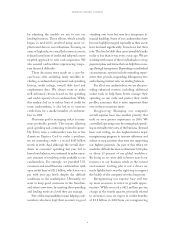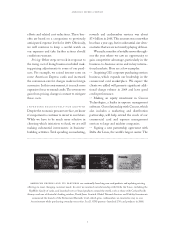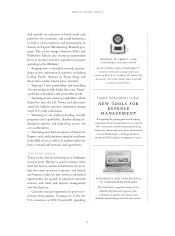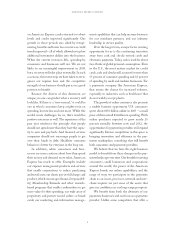American Express 2008 Annual Report Download - page 18
Download and view the complete annual report
Please find page 18 of the 2008 American Express annual report below. You can navigate through the pages in the report by either clicking on the pages listed below, or by using the keyword search tool below to find specific information within the annual report.
2008 financial review
american express company
critical accounting policies
The Company’s significant accounting policies are described in Note 1 to the Consolidated Financial Statements. The following
chart provides information about four critical accounting policies that are important to the Consolidated Financial Statements and
that require significant management assumptions and judgments.
reserves for cardmember losses
Description Assumptions/Approach Used Effect if Actual Results Differ
from Assumptions
Reserves for cardmember losses relating to
cardmember loans and receivables represent
management’s best estimate of the losses
inherent in the Company’s outstanding
portfolio of loans and receivables.
Reserves for these losses are primarily based
upon models that analyze specific portfolio
statistics, including average write-off rates
for various stages of receivable aging (i.e.,
current, 30 days, 60 days, 90 days) over a
24-month period and average bankruptcy
and recovery rates. These reserves reflect
management’s judgment regarding overall
adequacy. Management considers whether
to adjust reserves that are calculated by
the analytic models based on other trends,
such as the reserves as a percentage of past-
due accounts, reserves as a percentage of
cardmember loans and receivables, and net
write-off coverage. Other trends considered
include leading economic and market
indicators, such as the unemployment
rate, the consumer confidence index, the
purchasing manager’s index, bankruptcy
filings, concentration of credit risk based
on tenure, industry or geographic regions,
and the legal and regulatory environment.
Cardmember loans and USCS cardmember
receivables are generally written off when
they are 180 days past due, consistent with
applicable regulatory guidance. International
Card Services (ICS) and GCS cardmember
receivables are generally written off when
they are 360 days past due.
To the extent historical credit experience
updated for emerging market trends in credit
are not indicative of future performance,
actual losses could differ significantly from
management’s judgments and expectations,
resulting in either higher or lower future
provisions for losses, as applicable.
As of December 31, 2008, an increase
in write-offs equivalent to 20 basis points
of cardmember loan and receivable balances
at such date would increase the provision
for cardmember losses by approximately
$150 million. This sensitivity analysis does
not represent management’s expectations of
the deterioration in write-offs but is provided
as a hypothetical scenario to assess the
sensitivity of the provision for cardmember
losses to changes in key inputs.
The process of determining the reserve
for cardmember losses requires a high degree
of judgment. It is possible that others, given
the same information, may at any point in
time reach different reasonable conclusions.
16
























